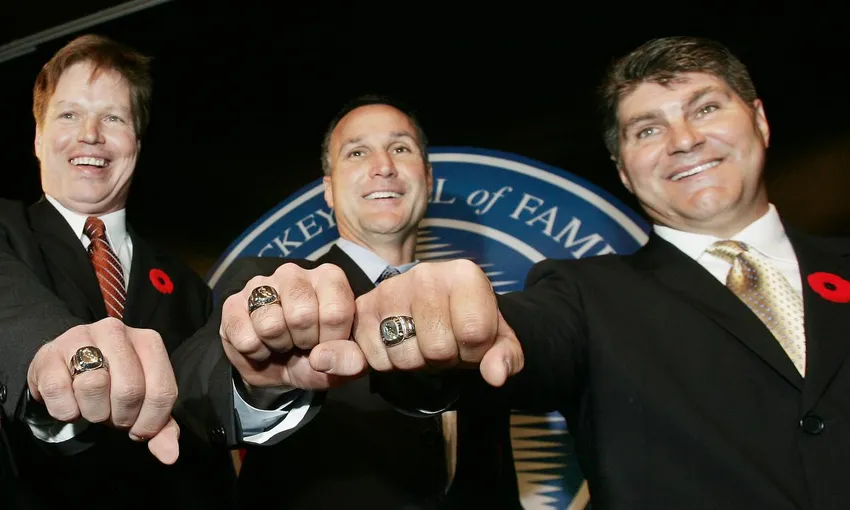Larry Murphy is embarking on a new journey.
The Hockey Hall of Fame defenseman from Scarborough already has an impressive resume: four Stanley Cup rings and 1,615 NHL games, including a couple of seasons with the Maple Leafs. Now a broadcaster covering the Red Wings, Murphy will coach Team Murphy in an innovative new barnstorming professional hockey league — 3Ice — that debuts this weekend and features 3-on-3 hockey.
“I’m excited,” Murphy told the Star in a phone interview. “I’m looking forward to being behind the bench. And I love the concept.”
Murphy has never coached but that doesn’t matter. Hockey like this has never been played at such a high level before: six teams of six players and a goalie playing a different tournament every weekend in a different city, over nine weeks, eventually crowning a champion.
It starts this weekend in Vegas and there are two stops in Canada (London, Ont., on July 16, Quebec City on July 30). Games are 16 minutes long — two eight-minute halves on regulation ice. Each weekend tournament is bracket-style, with the final championship tournament Aug. 20 in Vegas and $2.2 million (US) in prize money is up for grabs over the nine weeks.
It’s the brainchild of EJ Johnston, the son of former NHL goalie Eddie Johnston, and a mover-and-shaker in the TV and event management industries.
“The top four (teams) will make it to the championship playoffs on our final weekend in Vegas,” Johnston said. “And the winning team that night picks up $127,000 per man, plus whatever they picked up in the regular season. We think that our average in the regular season should be right around $36,000. So the top guys in this league are making about a $160,000 for nine Saturdays worth of work. That’s not bad.
Johnston took to 3-on-3 hockey when the NHL introduced it as an overtime feature and he has spent the last four years refining a business plan that’s paying off with multiple partners that will make 3Ice available in 165 countries, behind only the NHL. TSN, TVA, ESPN and CBS have all signed up as broadcast partners.
“We like to say we’re a different game played with the same rules,” Johnston said. “I love bigger bodies, getting into the corner and grinding it out. But that’s not what our game is. We’re Ferraris and Maseratis zipping up and down the ice. We’re looking for different body types, guys that are built for the 3-on-3 open ice.”
The players are not household names beyond their own households. Former Marlie Chris Mueller, a 36-year-old who played 53 NHL games, is an example of the kind of player the league attracted. Some Europeans, some ECHLers, some free agent college players.
The bigger names are the coaches, after whom the teams are named: former NHL stars Murphy, Grant Fuhr, Bryan Trottier, Guy Carbonneau, Joe Mullen and John LeClair.
Murphy says fans of skill and speed will love the games.
“It’s speed, puck possession. It’s what you see in that five minutes of (NHL) overtime,” Murphy said. “Rules are put in place to actually keep the flow continuous. Basically, the only faceoffs are at the start of each half. A team scores, you pull the puck out of your net and off you go. So you’re going to see continuous action. It’s going to be relentless for each half of eight minutes. It’s high-tempo, high-excitement hockey.”
The league has already had a dry run for the players and a scouting opportunity for the coaches who drafted their teams.
“The drafting experience was great,” Murphy said. “You got a little taste of the highs and lows of a draft where you have your heart set on a particular player and every pick you’re just dying, hoping that he doesn’t get grabbed.”
Johnston calls this a “snackable” version of hockey. And a wall down, high-scoring version of the sport may draw new fans, like rugby sevens has done for rugby. The tour, with a new champion every week, offers some other advantages.
“It’s better for us because it gives us the flexibility to move around and take our game wherever we want,” Johnston said. “If we crush it in a couple of places or we don’t do well in a place or two, great. We’ll switch it out.”
There’s another advantage for the players and coaches.
“We don’t have to have camps or physical location,” Johnston said. “Everyone who works with us, form Monday through Friday they’re living at home. They fly on Friday, they play Saturday, fly home on Sunday. So it’s a really an ideal model for all of our players.”
JOIN THE CONVERSATION
